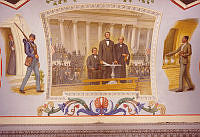Rubenstein Center Scholarship
The Formerly Enslaved Household of the Grant Family
This article is part of the Slavery in the President’s Neighborhood initiative. Explore the Timeline
Women are often overlooked in history for their role in the institution of slavery. First Lady Julia Dent Grant, wife of President Ulysses S. Grant, was a steadfast slave mistress for more than half of her life—an often forgotten part of her identity. Though Grant himself grew up in an abolitionist family in the free state of Ohio, his marriage to Julia Dent led him to become involved in slavery while the two lived in Missouri on Julia’s family estate. As a result, Ulysses Grant was the last U.S. president to have owned an enslaved individual. Grant’s legacy as the respected Commanding General of the Union Army, and his efforts as president to protect black citizenship have long obscured his personal slave-ownership, as well as that of his beloved wife.
Julia Dent Grant’s interactions with slavery are well-documented in her personal memoirs, first published in 1975. Her father, Frederick Dent, purchased a plantation in St. Louis, Missouri, in 1820.1 The plantation, called White Haven, ran using enslaved labor; Dent oversaw a workforce of approximately thirty enslaved individuals on two Missouri properties.2 In 1830, when Julia was only four years old, there were at least eighteen enslaved individuals at White Haven.3 In her reminiscences, she described growing up surrounded by enslaved servants like Henrietta, Sue, and Jeff, whom she considered playmates during her childhood, before assuming control over them in adulthood:
We always had a dusky train of from eight to ten little colored girls of all hues, and these little colored girls were allowed to accompany us… we would wander by the brookside, catch minnows with pin-hooks…I, being of very provident nature, required these little maids to each carry a bucket to bring home my captives.4

Slave quarters at White Haven, photographed in the twentieth century
Library of CongressIt was common for slave owners to allow their children to play with enslaved children who were close in age. These childhood years were formative periods where “white girls practiced techniques of slave discipline and management, made mistakes and learned from them, modified their behavior to meet various conditions, and ultimately decided what kind of slave owners they wanted to become.”5 Mary Robinson, the enslaved cook, along with Rose and Kitty, enslaved “nurses,” also played important roles in Julia’s upbringing.6
Ulysses S. Grant’s childhood was vastly different from Julia’s. Born in Ohio to Methodist parents, he was not raised with nor surrounded by the institution of slavery. His father, Jesse Root Grant, was an abolitionist who taught his son that slavery was cruel and immoral. Grant received a formal education and later enrolled at the United States Military Academy at West Point, where he befriended Julia Grant’s brother, Frederick “Fred” Tracy Dent. Fred was Ulysses Grant’s roommate at West Point, and the two became good friends during their time at school. After graduating in 1843, the U.S. Army stationed Brevet Second Lieutenant Grant in St. Louis; while in Missouri, Grant visited his old friend at his plantation, White Haven. There, Ulysses Grant met and fell in love with Julia Dent, and the two became engaged a year later. However, Grant’s military duties in the Mexican-American War led to a four-year separation; the two finally married in 1848.
After Grant resigned from the U.S. Army in 1854, he faced financial hardship. Having received eighty acres of land as a wedding gift from Julia’s father, the Grants returned to Missouri to live off the land. There, Ulysses Grant became increasingly involved in slavery at White Haven. Grant farmed alongside enslaved field workers daily, while also working with them to build a new home—this log cabin would come to be known as “Hardscrabble.”7 Grant left no record of how he felt about his new proximity to the institution of slavery, but he and Julia benefitted from their free labor after moving to White Haven.

"Hardscrabble" circa 1891. The cabin was built by enslaved laborers overseen by U.S. Grant
Library of CongressThese experiences working alongside enslaved individuals may have taught Grant how to supervise and discipline enslaved workers under his stead. The Dents were adept slave owners, with years of experience controlling the enslaved labor population at White Haven. Grant’s agricultural training under the Dents would have included many lessons regarding both farm and labor management, as Grant’s Ohio upbringing would not have prepared him for these tasks. According to historian William S. McFeely, Grant “tried to mold himself into the kind of farmer-planter his father-in-law was.”8 With these aspirations came slave-ownership, whether Grant approved of the practice or not.
Between 1857 and 1859, Julia’s father—aging and widowed—granted Ulysses Grant almost complete oversight of White Haven and the enslaved laborers there, truly testing Grant’s newfound knowledge of farming and labor management.9 A letter from Grant to his sister, Mary, in 1858 describes the progress he had made at White Haven in the supervision of both crops and enslaved people: “I now have three negro men, two hired by the year and one of Mr. Dents, which, with my own help, I think, will enable me to do my farming pretty well.”10 Though impossible to know how Grant felt about these interactions, Julia’s sister, Emma Dent Casey, wrote that “although I know that he [Grant] was opposed to human slavery as an institution I do not think that he was at any time a very rank abolitionist or that he opposed it so violently that the acceptance of Julia’s slaves had to be forced upon him.”11
Grant’s involvement in slavery eventually went beyond the “acceptance” and management of the Dent family’s enslaved laborers — Grant himself came into ownership of a man named William Jones from his father-in-law at some point during the 1850s.12 While there are no known documents or letters related to a bill of sale, Grant later emancipated Jones in 1859. The motivation behind this is unclear; with a number of enslaved individuals already at his disposal at White Haven and larger financial troubles, it seems unusual that Grant elected to become a slave owner. Whatever the reason, Grant assumed a more personal but short-lived role in the perpetuation of human bondage. On March 29, 1859, U.S. Grant manumitted “my negro man William, sometimes called William Jones, of Mulatto complexion, aged about thirty-five years…being the same slave purchased by me of Frederick Dent.”13 Many historians have pointed out Grant’s choice to manumit William Jones rather than sell him in a time of financial hardship for his family. Ronald C. White wrote that “Grant could have received at least $1,000 for this slave if he’d tried to sell him… at this point he could have surely used the money.”14

Facsimile of original manumission papers for William Jones
Courtesy Missouri Historical SocietyIn 1859, Grant’s financial problems (worsened by a bad harvest and a national economic panic that began two years earlier) led him to relocate his wife and four children to St. Louis.15 At this time, Julia asserted ownership of four enslaved individuals “gifted” to her by her father: Eliza, Dan, Julia (Jule), and John. Her legal proprietorship is unclear due to lack of documentation; it is likely that the enslaved individuals remained under her father’s legal ownership, and that he allowed Julia to utilize their labor as she began to manage her own household. In any case, she presented herself as a slave mistress and brought these individuals with her to St. Louis. According to Julia, these four enslaved people “were young, ranging from eighteen to twelve years of age. They were born at the old farm and were excellent, though so young.”16 While Julia managed Eliza, Dan, Jule, and John, Ulysses benefitted from the home they cleaned, the food they cooked, and the care they provided for his children.
As the Grant family’s financial situation worsened, Ulysses Grant decided to move to Galena, Illinois in 1860, to take a job promised to him at his family’s leather shop. To Julia’s disappointment, she had to hire out Jule, Dan, John and Eliza to “persons whom we knew and who promised to be kind to them.”17 Though Julia did not want to be separated from them, Illinois was a free state, and should they be emancipated, her father reminded her in a letter that she could not “do without servants.”18 Colonel Dent was correct; Julia’s dependence upon enslaved people became obvious during their absence. In her memoirs, she describes the revelations she had upon assuming domestic independence in Illinois; namely, Julia realized she did not know how to sew, cook, or care for her ailing children. One incident occurred when Julia attempted to make Maryland biscuits for Grant’s family in Galena. She complained in her memoir that “they were not at all like home biscuits… I presume that the cook would have done better if I had ever prepared any before… I had only cut out small cakes with my thimble from the dough prepared by my black Mammy.”19 Later, when Julia’s youngest son, Jesse, fell down a flight of stairs, she lamented that “I wished then I had never come to Illinois, nor left my faithful nurse [Jule].”20
Mrs. Grant did not have to survive without Jule for long. Although the fates of Dan, Eliza, and John are unknown, it is clear that upon leaving Illinois Julia reclaimed control of Jule, her most trusted enslaved nurse, when Ulysses Grant became a Colonel in the Union Army at the start of the American Civil War in 1861. As Grant rose through the ranks, ultimately assuming his position as Commanding General, Julia followed Grant through battle-ridden cities across America, with Jule in tow. In fact, Julia wrote in her memoirs that Jule “came very near being captured at Holly Springs.”21 This memoir entry demonstrates one way that Julia put Jule in harm’s way without her consent, but their proximity to battle also put them both in danger of imprisonment, disease, and death every day. Moreover, Jule’s status as a black woman created a heightened risk at the hands of Confederate soldiers, known to treat African-American prisoners more violently than their white counterparts.22

Emancipation ordinance from Missouri, January 1865
Library of CongressUnsurprisingly, Julia’s use of enslaved labor did not go unnoticed, especially as the wife of a Union officer. In 1862, Chicago Sunday Tribune Magazine reported: “Until we can secure pure men in habits and men without secesh [secessionist] wives with their own little slaves to wait upon them, which is a fact here in this camp with Mrs. Grant, our country is lost.”23
In 1863, the Emancipation Proclamation granted freedom to enslaved individuals in Confederate-held territory, but Missouri, a border state during the Civil War, was exempt from this act. As a result, Jule remained in bondage; Missouri would not abolish slavery until January 1865.24 Rather than languishing in wait for freedom, Jule self-emancipated—running away from the Grant family during a stay in Louisville, Kentucky in 1863 and eventually marrying. Julia Grant wrote that she “regretted this, as she was a favorite with me.”25 At White Haven, it is likely that many enslaved individuals owned by the Dent family similarly took advantage of the Civil War by running away.26
As Julia came to terms with the loss of Jule, Ulysses Grant vacillated over supporting abolition. Early in the war, Grant was not inclined to criticize slavery as a practice; in 1862, Grant wrote his father: “I am sure that I have but one desire in this war and that is to put down the rebellion. I have no hobby of my own with regard to the negro, either to effect his freedom or to continue his bondage.”27 Yet, as the war continued, Grant’s indifference to the abolitionist cause began to change. In 1863, Grant wrote to Elihu B. Washburn: “I never was an Abolitionist, [n]ot even what could be called anti slavery, but I try to judge farely and honestly and it become patent to my mind early in the rebellion that the North and South could never live at peace with each other except as one nation, and that without slavery.”28
Another factor which may have altered Grant’s perception of slavery was the enlistment of African Americans in the Union Army. African-American soldiers first began to serve in regiments in late 1862 in Louisiana, Kansas, and Tennessee. President Abraham Lincoln and the federal government were slow to enact legislation allowing for enlistment of black soldiers, but emancipation, as well as conversations with prominent abolitionist Frederick Douglass, convinced the president that recruitment of African-American soldiers would bolster the Union cause.29 Grant supported African-American enlistment, writing President Lincoln: "I have given the subject of arming the negro my hearty support. This, with the emancipation of the negro, is the heavyest blow yet given the Confederacy.”30 On May 22, 1863, the War Department formed the Bureau of Colored Troops, and by the end of the war in 1865, approximately 180,000 African Americans had served in the Union Army.31 Yet, these men (and sometimes women) faced unequal treatment, including drastically lower pay than their fellow white soldiers. In the end, the important role that African Americans played in the Union Army’s victory may have persuaded Ulysses S. Grant to support their cause later in his life. Click here to learn more about the household of President Abraham Lincoln.

Unknown African-American soldiers in the Union Army
Library of CongressThe post-war period was one of major transition for the Grant family. Though Julia had lost both her personal servant and her childhood home, her husband’s election to the presidency in 1868 was a joyful occasion. Julia was delighted to entertain, decorate, and enjoy life in the spotlight. Even better, the Grants—who were used to a large staff during the war—were again cared for by others once they moved into the White House, this time by paid men and women. While a number of first ladies in history have disliked this very public life, Julia Grant reveled in it; she even cried upon leaving the Executive Mansion in 1877, and scolded her husband for refusing to seek a third term.
Meanwhile, Grant’s presidency built upon his experience fighting alongside African Americans in the Civil War and led him to advocate for racial equality throughout his two terms. Grant attempted to rectify administrative shortcomings in the wake of President Andrew Johnson’s Reconstruction policies. Although many Americans—even those who opposed slavery—did not believe in enfranchisement for black citizens, Grant vocally supported the ratification of the Fifteenth Amendment. He opposed the rise of white supremacist groups in the South, like the Ku Klux Klan, and sent federal troops into the region to combat racism and curb violence. The Enforcement Acts, passed by Congress in 1870, provided new protections to African Americans and gave the federal government authority to intervene in any states that obstructed the rights of black citizens. Grant’s alliance with African Americans led to his reelection endorsement by Frederick Douglass, one of the most famous abolitionists of the nineteenth century. Click here to learn more about the enslaved households of President Andrew Johnson.
Douglass wrote in his memoir:
Though I worked hard and long, to secure the nomination and the election of Gen. Grant in 1872, I neither received nor sought office under him. He was my choice upon grounds altogether free from selfish or personal considerations. I supported him because he had done, and would do, all he could to save, not only the country from ruin, but the emancipated class from oppression and ultimate destruction.32
As president, Ulysses Grant also supported the migration of African Americans to areas outside of the continental United States—an idea previously held by other presidents including Abraham Lincoln, James Madison, James Monroe, and others. Click here to learn more about the enslaved household of President James Madison. Click here to learn more about the enslaved household of President James Monroe.
However, unlike previous presidential plans which aimed to remove a so-called “inferior race” from the United States altogether, Grant’s 1869 proposed annexation of Santo Domingo (present-day Dominican Republic) aspired to create an escape for African Americans from racial prejudice. Technically, the island would become an American state and remain a part of the country.33 He wrote:
[San Domingo] is capable of supporting the entire colored population of the United States, should it choose to emigrate. The present difficulty in bringing all parts of the United States to a happy unity and love of country grows out of prejudice to color. The prejudice is a senseless one, but it exists. The colored many cannot be spared until his place is supplied, but with a refuge like San Domingo his worth here would soon be discovered…34

This political cartoon criticizes Congressional Republicans like Charles Sumner for opposing U.S. Grant’s annexation treaty. Their opposition led to a major fissure in the Republican party.
Library of CongressGrant also hoped that racial equality in Santo Domingo might “extinguish that hated system of enforced labor” in other Caribbean nations, including the neighboring island of Cuba.35 Interestingly, Frederick Douglass was supportive of Grant’s plan and even traveled to Santo Domingo as Assistant Secretary to the Commission of Inquiry on the topic.36 Douglass and other abolitionists considered the island “an opportunity both to advance and to vindicate a radical vision of racial belonging.”37 Despite these efforts, the annexation was eventually impeded by President Grant’s political opponents in the Senate, who argued that imperial behavior in the Caribbean was as immoral as the slave-economy that the North had just abolished. Grant’s administration was also marred by scandal, leading to a legacy which often overlooks many of his political triumphs and his actions to protect African American citizens. Grant’s actions as president underscored a belief in racial equality that contradicted actions in his early adulthood. Similarly, Julia Grant supported her husband’s fight for racial equality in America, and made personal efforts to allow African Americans to attend her White House receptions, ordering ushers to “admit all who call.”38
After the presidency, Julia and Ulysses S. Grant kept in contact with a few of their former enslaved servants, including Mary Henry. Mary, who grew up with Julia, was interviewed by a Boston Globe reporter in 1900. She described her close relationship with Mrs. Grant: “I stood as close to her while she was being married as you are to my bed…when her children were born they were handed to me as they came into the world.”39 Before Henry died, Julia Grant sent her money and assured that she would be buried in the Dent family plot in Bellefontaine Cemetery, Missouri, but according to historians at the Ulysses Grant Historic Site at White Haven, “a search of Bellefontaine Cemetery's burial records indicates that while several women named Mary Henry are buried at the cemetery, no one by that name was buried there between 1867 and 1911.”40
Grant’s life is perhaps best documented within his personal memoirs, written as he was dying of throat cancer and published in 1885. Across two volumes, he documented his childhood, military service, Civil War leadership, and presidency in detail, and these volumes are often considered by historians to be one of the best sources on Grant’s life. It is important to note that within these memoirs, Grant made no mention of his personal role in the institution of slavery, though he accounted for national sentiment regarding abolition and accounted for the impact of slavery on the Civil War. In the preface of these memoirs, Grant warned that “there must be many errors of omission in this work,” but referred primarily in this statement to “officers and men engaged” in the Civil War.41

Ulysses S. Grant is pictured while writing his memoirs in June 1885. He died only one month later.
Library of CongressWithin the pages of these memoirs, Grant mentioned in passing his time at in Missouri but did not write about owning William Jones, farming alongside enslaved individuals at White Haven, or running the plantation in Frederick Dent’s stead. In describing the construction of “Hardscrabble,” a project that was completed primarily by enslaved labor, he simply wrote: “A house had to be built also. I worked very hard, never losing a day because of bad weather, and accomplished the object in a moderate way.”42
Though it is impossible to know if Grant purposely or unintentionally omitted his own slave-ownership from these memoirs, his choice was crucial in shaping the way that scholars and historians have discussed Grant’s relationship to slavery and abolition in the years following their publication. For almost a century after the completion of these memoirs, academics relied on Grant’s personal recollections for their own historical biographies; as a result, his legacy was often based off of what key moments he chose to include—and exclude. Though nineteenth century biographers like Hamlin Garland and William Conant Church discussed Grant’s interactions with the enslaved population at White Haven, his personal slave-ownership remained undiscovered for more than half a century; Lloyd Lewis’s Captain Sam Grant, published in 1950, appears to be the first mention of Grant’s ownership of William Jones.43
To this day, Grant and his family’s involvement in the practice of slavery is often overlooked, though it was a crucial part of their identity before moving into the White House. Their actions and choices serve as an example of the fact that women were key participants in the institution of human bondage, rather than innocent bystanders, and show that evolution in Grant’s stance towards slavery and African American equality benefitted the country in a number of ways. While President U. S. Grant’s personal opinion on slavery is still debated by historians, it is undeniable that his military and presidential leadership aimed to ease racial tensions in the American South and bolster African American rights in the Reconstruction Era, particularly in terms of enfranchisement.










